

|


Weathervane Newsletter Winter 1996

Book Review: Becoming Sojourner Truth
Nell Irvin Painter, Sojourner Truth: a Life, a Symbol. New York: W.W. Norton, 1996. Pp. x, 370. Cloth: $28.00.
Sojourner Truth is a historical figure and a cultural icon. Nell Painter seeks to unravel the layers of myth that surround the reality of Truth's experience, while pondering the underlying forces that gave rise to the need for these symbolic truths in her own time, and in ours.
Sojourner Truth, born Isabella, was a former slave who claimed the right to name herself, along with her freedom. At a time in the nineteenth century when a forceful women's voice was rarely heard in public, Truth, lacking formal education, but endowed with a sharp wit and an unadorned but powerful eloquence, spoke with authority and conviction to audiences across the northeast and Midwest.
Truth came to Northampton in 1843 to join the Northampton Association for Education and Industry - a utopian, abolitionist community organized around a communally operated silk factory in what is now Florence. Though living conditions at the Northampton Association were spartan, no other place, Truth later recalled, offered her the same "equality of feeling," "liberty of thought and speech," and "largeness of soul." It was in Northampton that Truth came into contact with abolitionists William Lloyd Garrison, Frederick Douglass and Wendell Phillips. Through them and other members of the Association, Truth was introduced to a wider world of nineteenth century reform. Thereafter, Truth would become well known not only in anti-slavery circles, but in the women's rights and temperance movements as well.
It was in Northampton that Sojourner Truth conceived of and completed her Narrative of Sojourner Truth. Dictated to Truth's friend, Olive Gilbert, and published in 1850 with the help of William Lloyd Garrison, the Narrative provided Truth with an independent means of support for the first time. With the first printing, she was able to purchase a house in Northampton; and the book's subsequent editions, along with a strenuous round of speaking engagements, provided her with a modest living for the rest of her life.
Painter shows us, however, that it was Harriet Beecher Stowe and feminist Frances Dana Gage who created images of Sojourner Truth that continue to persist in the historical imagination. Stowe and Gage published popular articles during the Civil War that embellished the threads of Truth's life for middle-class readers. In their hands, Truth became a kind of primal force whose primitive energy both attracted and repelled Victorians. Seeking to frame Truth as an advocate for their constituencies, they tended to play down the essential spiritualism which underlay much of her actions.
Painter gives us the historical complexities the contradictions and ambiguities in the life of a remarkable woman whose achievements need no embellishment to claim our attention. She also wrestles with the persistence of apocryphal stories and iconography that continue to characterize accounts of Truth's life. The need to sustain these symbols in the face of historical evidence to the contrary, Painter suggests, may tell us far more about our own time and our preoccupations than it reveals about Truth.
Contents Historic Northampton.